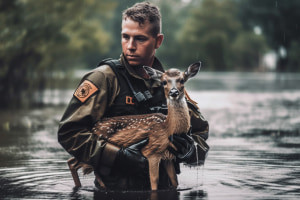The Significance of Burlington Animal Control for Area Health And Wellness
Wiki Article
Typical Obstacles and Solutions in Urban Wild Animals Removal Initiatives
Urban environments present distinct difficulties for wildlife monitoring professionals charged with taking care of or removing wild animals populations. These challenges usually converge with moral considerations, lawful frameworks, and the safety and security of both humans and animals. Public resistance and misconceptions even more complicate these efforts, necessitating cutting-edge, non-lethal options and durable community outreach. Recognizing the intricacies included in urban wild animals removal is vital for establishing strategies that balance human safety and security with wild animals well-being. What techniques have proven most effective, and exactly how can areas be much better engaged to sustain these initiatives? This discussion seeks to uncover the intricate balance required for effective urban wildlife management.Moral Wildlife Monitoring
Addressing the complexities of moral wildlife monitoring requires an equilibrium in between human passions and the preservation of wild animals communities. In urban setups, this equilibrium becomes significantly difficult as human growth encroaches on wild animals habitats, causing constant human-animal communications. Ethical wild animals monitoring in these atmospheres demands approaches that focus on gentle treatment of pets while minimizing prospective problems.One of the core concepts in ethical wild animals monitoring is the prevention of damage. This involves using non-lethal approaches for wildlife removal, such as exemption strategies that avoid pets from getting in human houses, or utilizing deterrents that direct them far from city locations. Wild animals experts are entrusted with utilizing methods that lessen stress and injury to the pets, ensuring their welfare is taken into consideration together with human safety.
Furthermore, honest monitoring requires informed decision-making based upon clinical research study and eco-friendly understanding. It is necessary to evaluate the ecological roles of metropolitan wildlife and how their removal might affect regional biodiversity. Experts should likewise participate in public education, cultivating a more comprehensive awareness of coexistence methods and highlighting the importance of preserving natural environments. Inevitably, effective moral wild animals monitoring includes collaboration in between conservationists, policymakers, and the public to sustain city ecosystems.
Browsing Lawful Constraints
Browsing the lawful landscape of urban wild animals elimination presents an intricate layer to the already challenging task of honest wildlife management. Lawful limitations are crucial in ensuring that wildlife is dealt with humanely and environments are protected. These legislations differ substantially throughout areas, requiring complete understanding and compliance from those associated with wildlife monitoring. Rules frequently define allowable approaches of elimination, protected species, and licensure demands, consequently shaping the approaches utilized by professionals.One significant obstacle is the constant development of these regulations, often driven by environmental changes and societal mindsets towards wildlife conservation. Experts should stay educated regarding existing lawful requirements and honest legislative changes. Non-compliance can lead to significant charges, lawful implications, and reputational damage.
In addition, collaboration with regional authorities can be essential in navigating these restrictions effectively. Structure connections with wildlife firms and legal professionals can provide valuable understandings and support. This partnership ensures that removal efforts are not just lawful however also straighten with more comprehensive preservation goals. Hence, understanding and adhering to legal structures is not simply a step-by-step need however a fundamental element of sustainable and responsible city wildlife monitoring.

Safety And Security in Elimination Practices
Guaranteeing safety and security in wild animals elimination practices is critical to securing both animal and human welfare. These efforts need a balanced method that lessens danger while attaining the wanted end result of relocating animals from urban settings. A primary issue in wildlife removal is the potential for injury or illness transmission to people, requiring the usage of personal protective devices (PPE) such as goggles, masks, and gloves. Trained professionals should handle eliminations to stay clear of aggravating the scenario, as inexperienced individuals may inadvertently harm themselves or the pets entailed.
Safe elimination practices additionally include the use of gentle traps made to stop injury. These catches should be routinely checked to guarantee that pets are not left in distress. Additionally, it is important to adhere to guidelines that determine the suitable handling, transportation, and launch of captured wild animals, ensuring that the animals are gone back to ideal habitats where they can prosper without posturing further dangers to city environments.
Moreover, education and learning and training for those involved in wildlife removal are crucial. This guarantees that all celebrations are mindful of the latest security procedures and strategies, thereby decreasing the probability of crashes and advertising an unified conjunction between urban residents and wildlife.
Ingenious Deterrent Solutions
While safety and security in wild animals elimination is essential, preventing encounters with metropolitan wildlife with ingenious deterrent options can dramatically lower the demand for such treatments. Urban settings, with their wealth of food and shelter, frequently draw in wildlife like squirrels, raccoons, and pigeons, causing possible problems. Innovations in modern technology and layout have actually led the method for efficient and creative deterrent methods that minimize wild animals visibility without injury.One such remedy is making use of ultrasonic tools, which send out high-frequency audios faint to human beings go to these guys but unpleasant for different wildlife varieties, driving them far from particular locations. In addition, motion-activated lawn sprinklers can discourage animals by shocking them with unexpected bursts of water, properly inhibiting their return. These gadgets are particularly valuable in securing gardens and environment-friendly areas from foraging pets.

In addition, the integration of clever lighting systems that change their illumination and color can interrupt the nighttime activities of specific wild animals, lowering their comfort in metropolitan setups. Physical barriers, such as bird spikes and nettings, remain to function as sensible deterrents, avoiding animals from nesting or roosting in unwanted areas. Emphasizing humane and environment-friendly approaches, these developments hold pledge for lasting city wildlife management.
Neighborhood Education And Learning Campaigns
Recognizing the importance of community education efforts is vital in addressing urban wildlife challenges efficiently. Such efforts play a considerable role in promoting coexistence between human beings and wildlife in urban setups by elevating awareness and advertising accountable behaviors. Enlightening homeowners regarding regional wild animals varieties, their environments, and habits can decrease visit their website misunderstandings and worry, causing more educated decisions regarding wildlife monitoring.Area education and learning initiatives commonly consist of workshops, seminars, and outreach programs designed to engage homeowners of every ages. These efforts can focus on practical advice, such as safeguarding waste containers, setting up bird-friendly structures, and staying clear of feeding wild animals, which assists avoid attracting pets into urban locations. By distributing knowledge concerning the eco-friendly functions of wild animals, neighborhoods can shift perspectives from checking out animals as nuisances to identifying their value within city environments.
Citizens who comprehend the relevance of wild animals conservation are more likely to support gentle removal methods and environment protection procedures - burlington wildlife rescue. Effective neighborhood education requires cooperation in between neighborhood authorities, wildlife experts, and community leaders to develop customized programs that attend to certain metropolitan wild animals problems.
Conclusion
Urban wildlife removal requires a diverse strategy, attending to moral monitoring, legal conformity, and safety and security in removal methods. Using ingenious deterrent solutions and prioritizing non-lethal techniques are vital for alleviating human-wildlife problem. Area education campaigns click here for more info play a substantial role in altering understandings and motivating coexistence by promoting an understanding of wildlife actions and lowering attractants. Effective metropolitan wildlife management depends upon cooperation amongst authorities, locals, and professionals, making certain approaches that guard human safety and security while respecting wildlife welfare.Urban settings present special obstacles for wildlife administration professionals tasked with getting rid of or managing wild animals populations. Comprehending the intricacies involved in metropolitan wild animals elimination is essential for establishing approaches that balance human security with wildlife well-being.Browsing the lawful landscape of urban wildlife removal provides an intricate layer to the currently challenging task of honest wildlife administration.While safety and security in wild animals elimination is vital, avoiding encounters with metropolitan wild animals with cutting-edge deterrent remedies can significantly decrease the requirement for such interventions. Successful metropolitan wild animals administration pivots on cooperation amongst authorities, citizens, and experts, making certain approaches that guard human security while appreciating wildlife welfare.
Report this wiki page